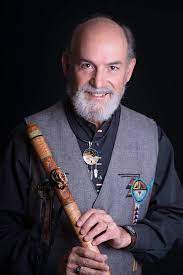Posted by Rachel Iacino on Sep 03, 2021 in Creativity, Writing, & the Arts

Where do Musical Ideas Come From? by Thomas Farber
Native American Flute is an instrument that pulls at you, and almost begs you to improvise and create. Any of us who’ve gotten involved in most any of the arts may be familiar with an old saying, that creating music (or other art) “is 10% inspiration and 90% perspiration”. My own experience reflects that.
I’ve long been very fond of Rocky Mountain National Park, and, at one point, thought that creating music to accompany the photographs I’ve taken there over the years would be something special. While that wasn’t what I had in mind when I began composing and arranging my own works centered on Native American style Flute, from the titles on my first album (“Fluting in the Rockies”), you can believe that the music dedicated to this National Park is very much on my mind.
Creating A Theme
Composing for Native American Flute can start with a couple of notes; maybe a particularly appealing rhythm; or a riff from a time when you’re just improvising. Putting together my first song for recording, I was inspired by the call of a mourning dove , which was unusual for the rhythm of the call. I invented another under some pressure at a songwriting seminar – at least the core of the song. Others came from a phrase that was invented while improvising, and with a recorder going that captured the improvisation, then taking the phrase that I liked and building on it. One of my songs originated in order to explore the capabilities of a triple-chambered flute. I created some to reflect the feeling of going up a particular trail or being in an area of the National Park. They all begin with an idea, followed by putting the idea to paper, then playing with and expanding on that idea. From that base comes ideas about what accompanying percussion, instruments, sounds and textures would enhance the melody. Harmonies might also play a part.
Inspiration… Then Perspiration
The theme or “motif” developed from the early idea is the “inspiration”; the rest is the “perspiration”. Trying things out, discarding some, adopting others. Recording the ideas and seeing how they blend – or don’t. Playing the song for others to see how they hear it. Going back and doing more refinements, additions, alterations. The great composer, Quincy Jones, is to have once said that composing music is like painting a 747…lots of detail, lots of work. It’s the excitement and satisfaction that comes as you create the music that keeps you painting that proverbial airplane.
Once you get comfortable writing your own music, it can make it easier to think of yet more things you could do. It’s a passion, an investment of time and creative energy, but the rewards are significant (not necessarily monetary rewards…most good musicians make a living, or need a “day job” to make ends meet). It’s the personal satisfaction of having created music that people like to hear that makes all the effort worthwhile.
Check out Tom’s new CD
Have a soothing listen to Tom’s latest recording, inspired by the Rocky Mountains.
Visit the website for Tom’s CD here.
Learn how to play
Do you love the sound and want to learn how to play? Sign up for class with Tom at Colorado Free University HERE. The next beginner level session starts 10/17/21, (4 Sundays). All students have the opportunity to purchase a Native American Flute in class!
What students have said about Tom’s Native American Flute classes at CFU
“Excellent teacher–knowledgeable & fun!”
“Tom is versatile, he has a wide range of talents with flutes and drums. He take you to your highest levels. Wonderful teacher!” [His class] brought me much joy!”
“Tom’s a great teacher, loves his subject matter wand hows everything! Info I didn’t know existed!”
“Tom is on e of the best instructors I’ve had at CFU, and I’ve been coming for 20 years! “
“Tom is supportive, encouraging, knowledgeable, skilled at playing & teaching.”
